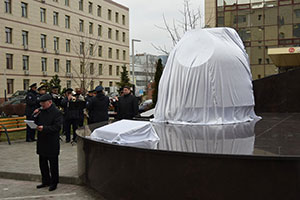 advertisements advertisements
|

|
Soyuz capsule that flew emergency abort lands on display in Moscow
December 4, 2019 — A Russian space capsule that carried its crew to a landing after the rocket it was atop broke apart mid-flight has touched down in Moscow as a monument to mission safety.
The Soyuz MS-10 descent module that on Oct. 11, 2018 made an emergency return to Earth with cosmonaut Aleksey Ovchinin and astronaut Nick Hague was unveiled as part of a new installation outside of the headquarters of the Russian space agency Roscosmos on Monday (Dec. 2).
"What happened proves the most important thing: there is nothing more important than flight safety," said Dmitry Rogozin, director general of Roscosmos. "We decided to put the descent module here, next to the head office of the State Corporation Roscosmos, for the simple reason that we all need to remember that day and not forget about our duty that we must do everything so that our space program works without failures."
The monument displays the gumdrop-shaped craft atop a raised granite base backdropped by a rising wall that is adorned with the Roscosmos insignia and the inscription, "Descent Module, Crew Capsule, Soyuz MS-10" in Cyrillic. A plaque mounted in front of the spacecraft details its history.
Launched from the Baikonur Cosmodrome on a mission to deliver Ovchinin and Hague to the International Space Station, the Soyuz MS-10 spacecraft executed an abort two minutes into its ascent after its Soyuz FG rocket's first and second stages collided during separation. The MS-10 vehicle fired its thrusters to get clear of the failing booster and then followed a ballistic trajectory, reaching an apogee of 58 miles (93 kilometers) before landing 250 miles (402 kilometers) from the launch site on the steppe of Kazakhstan.
The entire flight lasted just under 20 minutes long.
An investigation later found that the launch failure was the result of a sensor that was damaged during the rocket's assembly at the cosmodrome.
Ovchinin and Hague, having survived the abort, launched again in March aboard Soyuz MS-12. They returned from the space station in early October.
On Monday, the two crewmates attended the monument's dedication and helped to unveil their original spacecraft from under a white drape.
Hague was also honored. Rogozin presented the NASA astronaut with the Order of Courage, a Russian award that recognizes selfless acts of courage and valor.
"Nick, you deserve to get this decoration," said Rogozin, as he pinned the medal to Hague's U.S. Air Force uniform, according to state media reports.
The director general thanked both Ovchinin and Hague for their "courage, self-control and the highest professionalism shown in these 'difficult, difficult minutes,'" Roscosmos described on its website.
The MS-10 spacecraft was only the third Soyuz to fly an abort, after a similar in-flight rocket failure in 1975 and a fire on the launch pad in 1983. The Soyuz MS-10 launch was the 139th flight of a Soyuz vehicle. |
|

Russia's Soyuz MS-10 descent module, which in 2018 executed an in-flight abort, is now on display as a monument to mission safety at Roscosmos' headquarters in Moscow, Russia. (Roscosmos)

Russia's Soyuz MS-10 descent module is seen prior to its display's unveiling at Roscosmos' headquarters in Moscow. (Roscosmos) |

Roscosmos cosmonaut Aleksey Ovchinin (at far left) and NASA astronaut Nick Hague (second from right) are joined by Roscosmos director general Dmitry Rogozin and NASA astronaut Kate Rubins at the dedication of a monument to the Soyuz MS-10 aborted space mission outside of Roscosmos' headquarters in Moscow, Russia, on Monday, Dec. 2, 2019. (Roscosmos) |
|

© 1999-2025 collectSPACE. All rights reserved.
|
|

|

|
